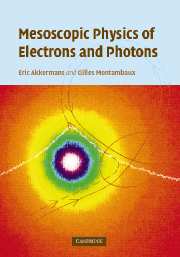Book contents
- Frontmatter
- Contents
- Preface
- How to use this book
- 1 Introduction: mesoscopic physics
- 2 Wave equations in random media
- 3 Perturbation theory
- 4 Probability of quantum diffusion
- 5 Properties of the diffusion equation
- 6 Dephasing
- 7 Electronic transport
- 8 Coherent backscattering of light
- 9 Diffusing wave spectroscopy
- 10 Spectral properties of disordered metals
- 11 Universal conductance fluctuations
- 12 Correlations of speckle patterns
- 13 Interactions and diffusion
- 14 Orbital magnetism and persistent currents
- 15 Formulary
- References
- Index
Preface
Published online by Cambridge University Press: 06 January 2010
- Frontmatter
- Contents
- Preface
- How to use this book
- 1 Introduction: mesoscopic physics
- 2 Wave equations in random media
- 3 Perturbation theory
- 4 Probability of quantum diffusion
- 5 Properties of the diffusion equation
- 6 Dephasing
- 7 Electronic transport
- 8 Coherent backscattering of light
- 9 Diffusing wave spectroscopy
- 10 Spectral properties of disordered metals
- 11 Universal conductance fluctuations
- 12 Correlations of speckle patterns
- 13 Interactions and diffusion
- 14 Orbital magnetism and persistent currents
- 15 Formulary
- References
- Index
Summary
Wave propagation in random media has been the subject of intense activity for more than two decades. This is now an important area of research, whose frontiers are still fuzzy, and which includes a variety of problems such as wave localization (weak and strong), mesoscopic physics, effects of electron–electron interactions in metals, etc. Moreover, since many disorder effects are not truly specific to a given kind of wave, various approaches have been developed independently in condensed matter physics, in optics, in atomic physics and in acoustics.
A large number of monographs or review articles already exist in the literature and they cover in detail various aspects of the field. Our aim is rather to present the basic common features of the effects of disorder on wave propagation and also to provide the non-specialist reader with the tools necessary to enter and practice this field of research.
Our first concern has been to give a description of the basic physical effects using a single formalism independent of the specific nature of the waves (electrons, electromagnetic waves, etc.). To this purpose, we have started with a detailed presentation of “single-particle” average quantities such as the density of states and elastic collision time using the framework of the so-called “Gaussian model” for the two most important examples of waves, namely Schrödinger and scalar Helmholtz wave equations. We have tried, as much as possible, to make precise the very basic notion of multiple scattering by an ensemble of independent effective scatterers whose scattering cross section may be obtained using standard one-particle scattering theory.
- Type
- Chapter
- Information
- Mesoscopic Physics of Electrons and Photons , pp. xiii - xivPublisher: Cambridge University PressPrint publication year: 2007

